When visiting the Mekong Delta, it would be a mistake not to experience the floating markets and discover the bustling life on the water of the local people. Among many destinations, Cai Rang (Can Tho) is one of the famous floating markets, loved by many tourists. This place offers you interesting experiences in exploring the Western land.
1. Where is Cai Rang floating market located?

Cai Rang floating market is about 6km from the center of Can Tho city by road, located near the Can Tho River, quite close to Cai Rang Bridge. To reach Cai Rang floating market, it takes a 30-minute boat ride from Ninh Kieu pier. You can see the floating market from National Highway 1A or from An Binh market under Cai Rang Bridge in Ninh Kieu district.
2. Guide on how to get to Cai Rang floating market without being ripped off
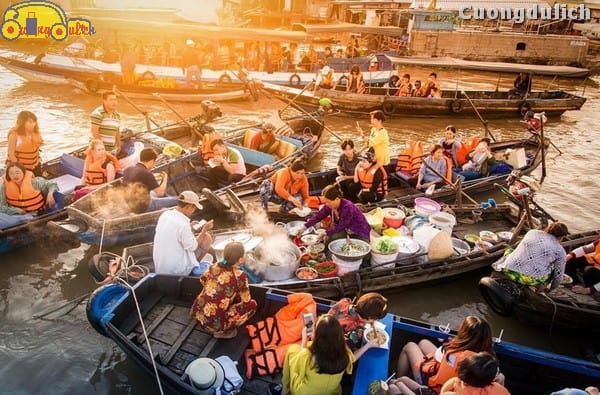
When you come to Ninh Kieu Wharf, you can rent a boat for around 70k per person (2-hour tour). If you want to visit the Can Tho fruit garden and the pizza noodle soup bakery, it will cost an additional 20k per person (4-hour tour).
If you visit the floating market Cai Rang in a small group, you can join a group to save money. But if you travel to Can Tho in a group, with a company, or with a group of backpackers, or simply if you don’t want to join a group, you can rent a private boat to explore the Cai Rang floating market, but the price will be much higher.
When you arrive at the floating market, the boat will take you around Cai Rang market to buy seasonal produce from the gardens and enjoy the local dishes here. Besides, you will immerse yourself in the bustling atmosphere of the floating market and learn about the life of the people in the river region.
For young people who rent a motorbike to explore Can Tho city, you can ride to An Binh market near Cai Rang bridge, park your bike, then go deeper into the market to find the boat dock, or ask the security guard right at the An Binh market parking lot.
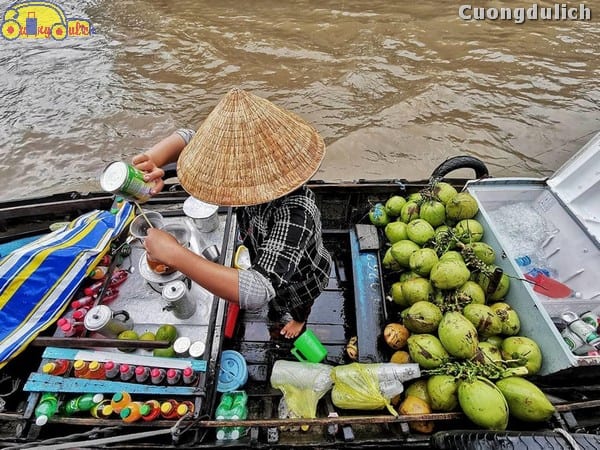
There are many ticket sellers near the market, so first-time visitors may easily buy overpriced tickets and have to join a group, causing inconvenience. You should only buy tickets at two stops, inside An Binh market and across Cai Son bridge. If you are unsure of the way, you can ask the parking attendants at An Binh market, they will guide you attentively.
Usually, the ticket price for a 45-minute ride around the floating market is about 150,000 VND for a group of 1-4 people, and 200,000 VND for a group of 5-9 people. You don’t need to buy tickets early if you are visiting Cai Rang floating market independently because the service boats are quite crowded, so you won’t run out of tickets. Additionally, many travel companies or hotels in Can Tho often sell tours to tourists for around 120,000 VND per person, departing at 5 am and 7 am, you can also contact the hotel you are staying at in Can Tho to see if they offer tours to Cai Rang floating market.
The boat will take you from Ninh Kieu pier, along the Can Tho river to Cai Rang floating market, go around the market, have some food, and then return. The advantage of taking a tour is the low price, and you can negotiate if you are in a large group and sit on a big boat. However, you will have to depend on the seller’s schedule and the group’s itinerary.
3. Which season is the best to visit Cai Rang floating market?
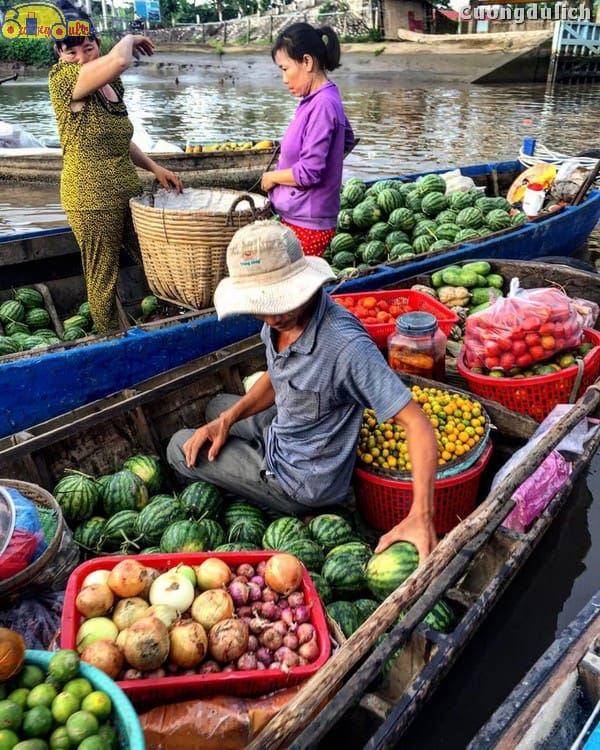
Unlike the Northern region of Vietnam, the climate in the Western region in general and Can Tho in particular is very pleasant and comfortable. The climate is hot and humid all year round, with very little cold weather or storms. There are mainly two seasons here: the dry season from December to April of the following year and the rainy season from May to November. Therefore, you can visit this Western land at any time of the year.
In addition to visiting the floating markets, tourists can also explore many other places such as the ancient house of Binh Thuy, My Khanh ecotourism garden… all of which are considered beautiful Western landscapes that are worth a visit. Especially, visitors should come during the 15th of the Lunar New Year to participate in the Upper Temple festival or on the 15th of April for the Lower Temple festival – both are the biggest festivals in Can Tho.
Furthermore, in the 3rd lunar month, there is the Cholchonam Thomay festival (New Year celebration) of the Khmer people, and the worshiping festival of Ong Ba (Dolta) takes place in the 8th lunar month…
4. When is the best time to visit Cai Rang floating market to find the most delicious dishes?

The floating market of Cai Rang usually gathers from early morning until around 8 to 9 am before dispersing. Typically, each boat specializes in selling a specific type of goods, with a pole at the front of each boat displaying the merchandise being sold for easy identification by buyers.
The market is busiest around 7 am, and on Tet holidays, the market is less active. Visitors can enjoy the fresh air, cool breeze from the river, blending with the sound of boat engines, paddles hitting the water, and the bustling trading activities along the river.
Similar to other floating markets in the Mekong Delta, the Cai Rang floating market starts in the early hours, around 2-3 am, with boats loaded with goods for distribution. Watermelons, mangoes, longans… are piled up on the boats.
If you can wake up early, this is the ideal time to immerse yourself in the culture of the river. However, it is still dark at this time, making it difficult to take good photos unless you are a professional photographer. It is advisable to go with a local guide to avoid getting lost.
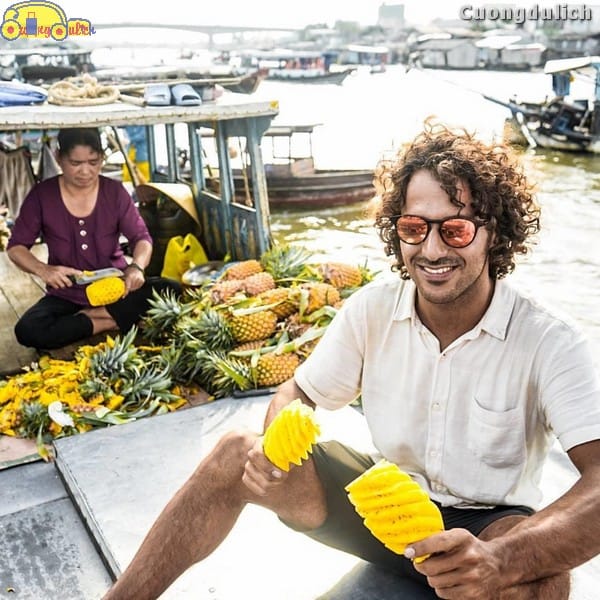
5 am – 6 am is the golden hour for tourists. Therefore, if you don’t want to miss the bustling and lively moment, you should depart at 4:30 am to arrive at the market at 5 am. The sun is just rising, and the trading boats are gradually spreading out, making way for food boats, fruit boats from the orchard, and tourist boats.
On each boat, there are bamboo poles hanging the goods that the boat owners sell, and customers choose based on that. For those who are “late risers,” Cuong knows that waking up between 5-6 am is truly a challenge, but it’s not often that you get the chance to visit the floating market of Cai Rang, waking up early one day to experience the culture of the Western river region is worth it, right?
By around 9 am, the market disperses, but for the “late risers,” 7 am is the last chance to get on a boat to the market, as by 7:30 am, there are only a few small boats selling coffee, and the scene is no longer bustling. The delicious boat noodles, crab noodle soup… are sold out.
If you’re hungry, you have to go to the riverside eateries for breakfast, which is not cheap (around 40,000 VND/small bowl), and the quality is average. On the other hand, enjoying food, an iced coffee on the boat, swaying on the river will be more exciting than sitting in a restaurant. When visiting the floating market, you must experience the feeling of eating on a boat, swaying on the river, rather than sitting in a restaurant, right?
5. Discover the delicious “lost” dishes at Cai Rang floating market
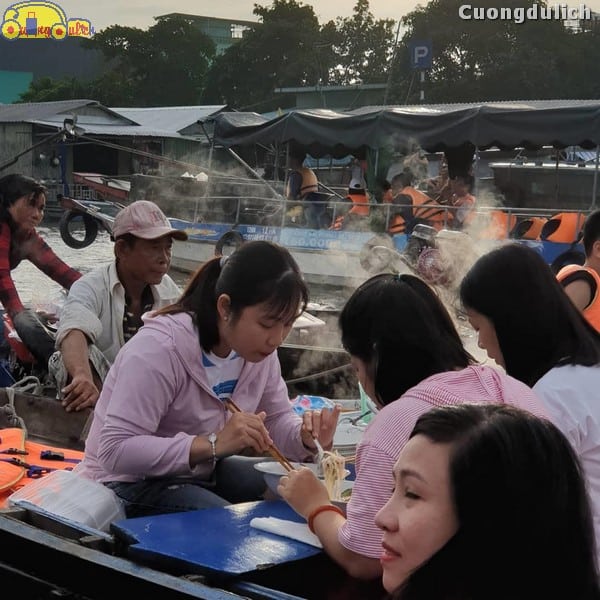
Not many people know that the floating market named Cai Rang in Can Tho is honored to be chosen by the British travel magazine Rough as one of the most impressive markets in the world. Each boat or ship will sell a product, which could be everyday items, handicrafts, dried foods like rice, cereals, sweets… or delicious and fresh fruits just picked from the orchard.
Although it is just a floating market on the river, using boats and ships as means of transportation, Cai Rang is as bustling as any market on land. If you have the chance to visit here, you will never forget the unique specialties that the floating market offers.
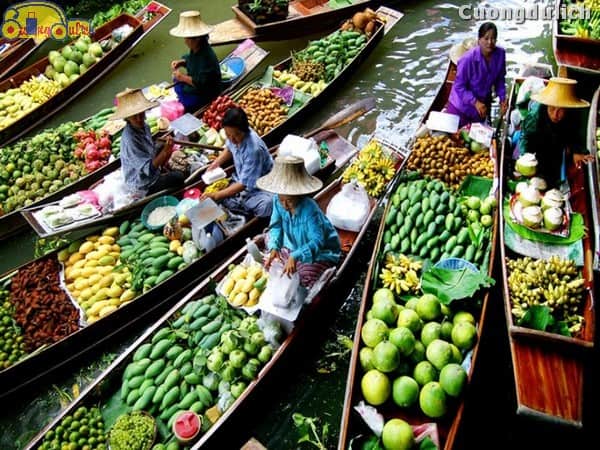
This is the bustling atmosphere, with sellers and buyers bustling around while the sky is still dimly lit, the sun has not yet risen. It’s the delicious fruits freshly harvested from the gardens of the Mekong Delta. It’s the dishes with the rich flavors of the rivers and waterways that can’t be found anywhere else… All these unique specialties have made this market a famous delicacy of the Western land, enchanting millions of tourists from all over the world every year.
Especially, to help buyers easily identify the products they are selling, the sellers have come up with a very impressive and unique initiative. Imagine the scene of the floating market of Cai Rang with hundreds of boats moored selling various agricultural products. How can tourists distinguish what they need to buy among hundreds of large boats? The people of the river region have come up with a very clever way to advertise their products. They hang what they sell on a pole high above. Buyers can easily see what each boat is selling from a distance, making it easier to search. You just need to point towards the boat and call out, and immediately the seller will row the boat over.
Here are some delicious and unique specialties at the Cai Rang floating market that Cuong has tasted and reviewed for you:
5.1 Crab noodle soup
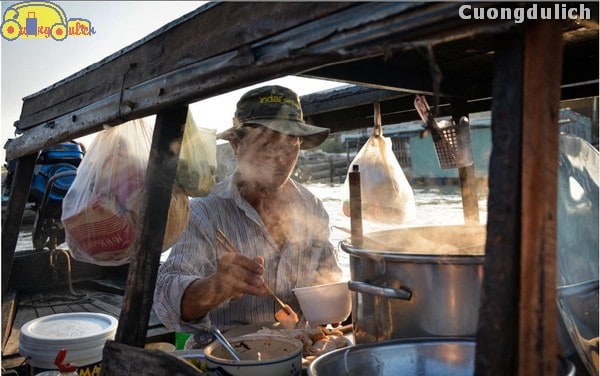
Bún riêu is also one of the dishes that leave a strong impression on diners because of its distinctive shrimp paste flavor. A bowl of bún riêu is visually appealing with the red color of tomatoes, green color of scallions, meat, the fragrant aroma of shrimp paste, and a hint of spicy chili that will surely make you delighted.
5.2 Hủ tiếu
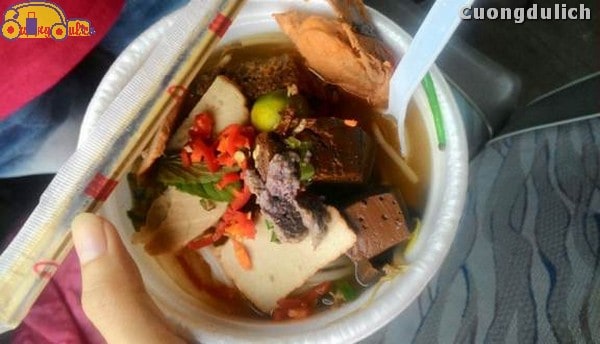
There are many dishes for tourists to choose from, among which hủ tiếu is the most familiar. Just with hủ tiếu noodles, some pieces of pork, quail eggs, and spring onions, you can have a delicious meal. The feeling of picking up a strand of hủ tiếu with chopsticks on a swaying boat every time another large boat passes by will make you feel excited and delighted.
5.3 Grilled meat vermicelli
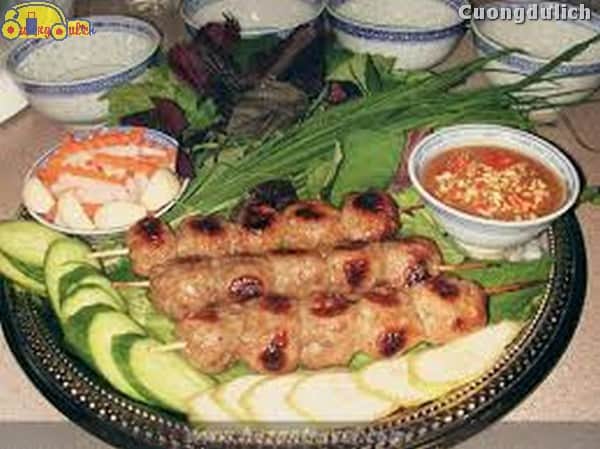
No spring rolls or grilled beef wrapped in betel leaves are commonly seen, the box of grilled meat vermicelli on the rustic Cai Rang river includes fresh vermicelli, a few pieces of meat, and raw vegetables. The pork is cut into small pieces, marinated with various spices to taste and grilled lightly beforehand. When sold to customers, the cook will grill it again to heat it up before putting it in the box. The meat is tender, fragrant, and flavorful.
Being on a boat, a slight carelessness can ruin the dish. Therefore, the cooking process requires the cook to be very careful and skillful. That’s why the locals here continue to trade as usual as if there were no difficulties. The bowls of vermicelli are passed around effortlessly, hot and delicious.
5.4 Pork offal congee
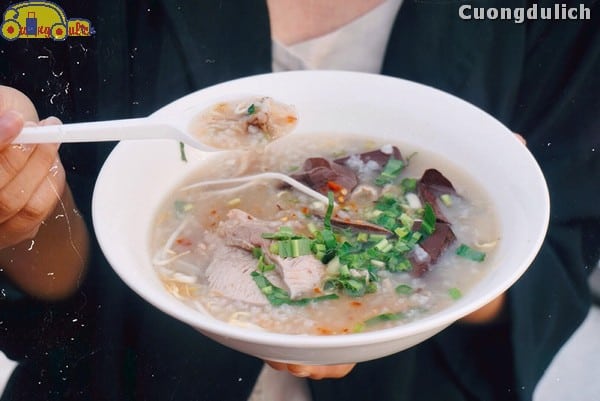
Another breakfast dish you should try is “cháo lòng”. The bowl of porridge on the boat is not as special as the ones on the shore. It’s just a few pieces of meat and liver, blood, a few bean sprouts, and finely chopped green onions, but anyone who has tried it always praises its deliciousness.
5.5 Bánh mì
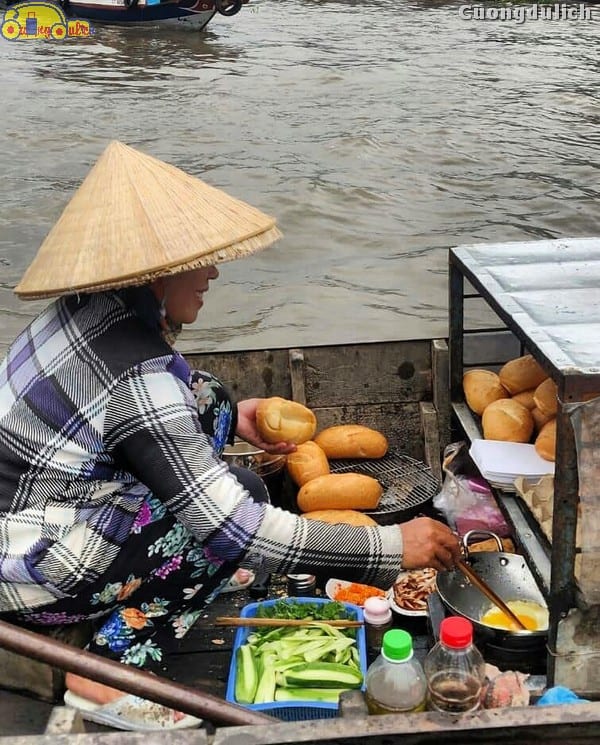
Warm baguette taken out of the charcoal oven with fillings of meat, cucumber, and egg, bringing an irresistible flavor. This dish immediately conquers even the most picky diners.
5.6 Sa Dec Dry Noodles

This is a special type of hủ tiếu from the Sa Đéc region, one of the famous specialties of Cần Thơ province. Looking at the plate of hủ tiếu with big, white, fresh hủ tiếu strands, topped with sliced heart, liver, pork meat, a bit of chives, finely chopped fresh lettuce, and fried shallots to enhance the attractiveness of the dish. The most noticeable point that everyone must pay attention to is the rich yellow sauce poured over the bowl of hủ tiếu. In fact, that is the secret that creates a unique, delicious taste when eating.
Each strand of soft and chewy hủ tiếu, combined with the rich and creamy sauce, with the aroma of fried shallots, sweet meat, and fresh green vegetables, creates a delightful sensation.
5.7 Savory Bánh đúc
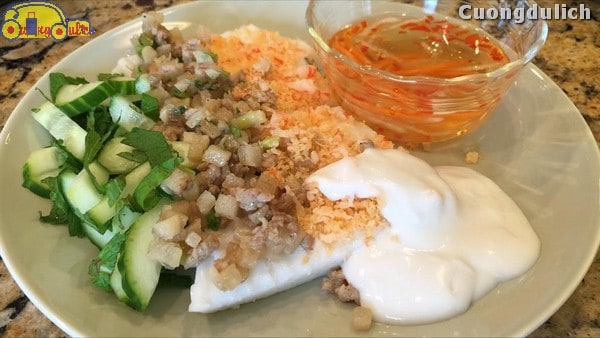
In fact, bánh đúc is not a luxurious or exotic dish, it is simply a dish that appears in all three regions of North – Central – South, and there are up to twenty different types. Each type of cake in each region possesses different characteristics, enough for each person to experience and warm their hearts. However, the savory bánh đúc in Can Tho has a very different flavor.
A tray of bánh đúc usually doesn’t have much, except for a few jars of shrimp paste, coconut milk, lard, onions, minced shrimp and meat, cucumber, herbs, and a tray of pure white bánh đúc flour. The fragrant cake flour combined with the rich taste of coconut milk and the salty flavor of shrimp and meat make this seemingly strange dish attractive, delicious, and strangely satisfying. If you have eaten savory bánh đúc before, sometimes you will wonder why this dish is so simple, so rustic, yet it continues to exist in your subconscious.
5.8 Grilled sticky rice bananas
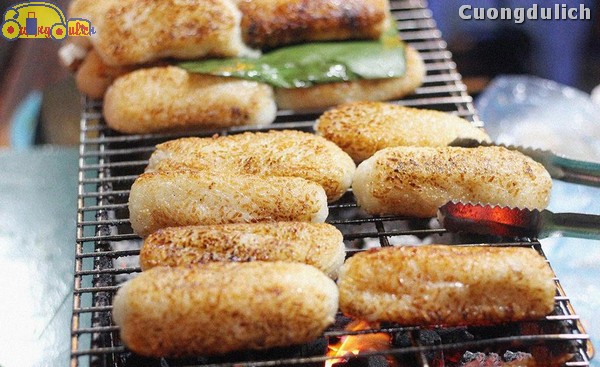
Unlike the long and slender grilled sticky bananas in Saigon, in My Tho, the bananas are large enough that eating just one can make you feel full, while in Can Tho, the bananas are small and not overly ripe. The grilled sticky bananas in Can Tho are delicious because of the crispy brown outer layer, the soft white inner layer, and the perfectly ripened yellow color of the bananas. It can be said that this dish is not about extravagance, but simply a delightful treat. Eating it once will make you addicted to the fragrant and rustic flavor of this grilled banana dish.
5.9 Bánh tầm bì
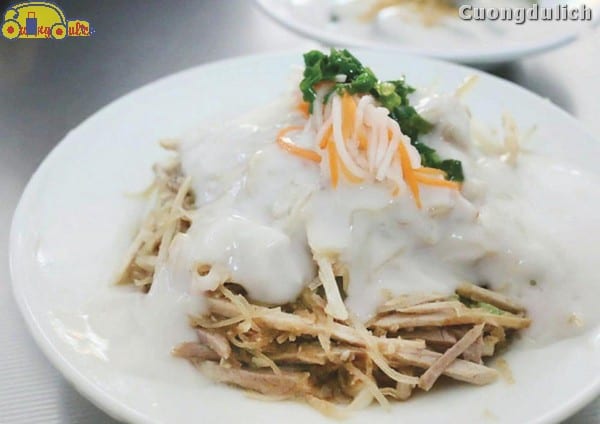
The Cần Thơ Tầm Bì cake has a very special flavor: the cake is always hot because it is steamed in a basket on a charcoal stove. When you see the shiny, fatty, delicious slices of pork skin, you will feel somewhat moved.
This cake is made from two main ingredients: the cake and the pork skin. While the cake is made from mixed flour, pressed into molds and steamed; the pork skin is boiled soft, thinly sliced, then cut into strips and mixed with roasted rice flour, finely chopped fresh garlic, golden fried garlic, sugar, salt…
When enjoying it, people usually serve the Tầm Bì cake on a plate with some pickled vegetables, fresh herbs, rich coconut milk, topped with a spoonful of fried shallots and eaten with sweet and spicy chili fish sauce. The soft texture of the cake blends with the coconut milk, crispy pork skin, sweet meat, and the light fragrant taste of various herbs have created a wonderful dish.
5.10 Bánh cống

Bánh cống is a rustic cake that anyone who has tried it once will not easily forget. People in Can Tho consider bánh cống as a snack to be eaten in the afternoon or evening. In the past, the cống used to pour the cake was carved from a bamboo trunk, later people made cống from aluminum to make the cake bigger, more durable, and shaped like a coffee filter with a handle or a water dipper, so it was called bánh cống.
The main ingredients to make the cake are flour, mung beans, and shrimp. The cake dough is prepared through many stages. The cake dough is meticulously prepared from plain rice flour, glutinous rice, wheat flour… Mung beans are peeled, cooked until soft but not mushy. Minced pork is stir-fried until cooked, mixed with mung beans. All are put into the cống, immersed in hot oil in the pan until golden and crispy.
Looking at the golden cake on the plate with a basket of fresh green vegetables is enticing enough to make you want to taste it. Taking a bite of the cake, you will feel the aroma of mung beans, meat, and shrimp fried together, creating a delicious scent. Then comes the spicy sensation when dipping it in a bowl of fish sauce with crushed chili, lime, and a few slices of sour papaya… all creating a richly colorful and uniquely flavored dish.
5.11 Fermented fish hotpot
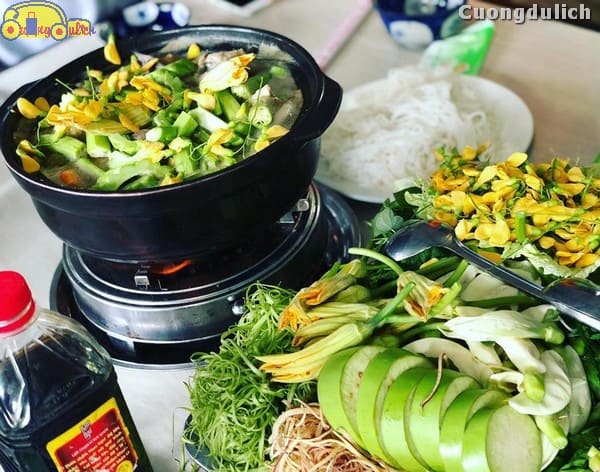
Shrimp paste hotpot is a rustic and unique dish of the Mekong Delta, characterized by many culinary elements typical of the region’s rivers and waterways, combined with ingredients processed from freshwater fish, river fish, and various vegetables readily available in home gardens. Those who are food connoisseurs all praise Can Tho shrimp paste hotpot as one of the best nowadays. However, for the shrimp paste to be delicious, it must originate from Chau Doc – the paradise of unique shrimp paste varieties.
Shrimp paste hotpot must contain at least three types of shrimp paste: solid shrimp paste for fragrance; mixed shrimp paste to enhance the rich sweetness and distinctive color; and liquid shrimp paste to create the special fatty taste of freshwater fish. A delicious shrimp paste hotpot is not overly salty, the pot must have a distinctive brown color, the broth should be thick thanks to finely chopped garlic and chili, combined with lemongrass. After cooking to bring out all the flavors of the shrimp paste, strain it thoroughly; add fresh coconut water and bone broth to the shrimp paste mixture, simmer on low heat to soften the shrimp paste and the gentle aroma of coconut water, creating a fragrant smell. The broth of the shrimp paste hotpot must have a delicious and rich flavor.
In addition to delicious shrimp paste, the hotpot cannot be without eggplant, pork belly, snakehead fish, snakehead fish, squid, shrimp, fish cake… Especially, green vegetables will help enhance the delicious taste of the hotpot. The vegetables for the hotpot are also diverse, from familiar to rustic with various flavors such as sour, bitter, sweet, and astringent like banana flowers, water spinach, water mimosa, bitter vegetables, water lily, water morning glory, pumpkin flowers, green cabbage, dragon beans, and water mimosa flowers…
Especially, enjoying shrimp paste hotpot can be accompanied by delicious fish sauce or tamarind fish sauce combined with fresh chili to add more excitement to the dish. Enjoy shrimp paste hotpot once to learn more about a part of the soul of Western cuisine, and you will surely remember this dish forever.
5.12 Swamp mud hotpot

The extremely rustic ingredient is the bần fruit, and the people of Can Tho have created a gentle and easy-to-eat bần hotpot. Bần hotpot is not only attractive because of the name “bần fruit” from the countryside, but also because of the distinctive flavor of the dish. The sour taste of bần hotpot is very refreshing and mild. When enjoying bần hotpot, diners can easily feel the subtle fragrance of the bần fruit, reminiscent of the “scent of the countryside breeze.”
Bần hotpot is cooked with various types of fish depending on the season. Nowadays, even more “sophisticated” diners like to taste bần hotpot cooked with snakehead fish. You can also enjoy bần hotpot with fresh noodles, and various local vegetables from the Western river region such as water lily, so đũa, điên điển, sliced banana flowers, etc.
5.13 Dried fish mango salad
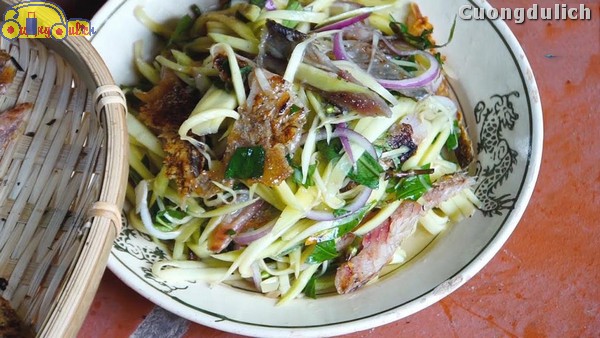
Dried mango salad with dried fish in Can Tho is a quite famous dish in Can Tho cuisine, simple but captivating many diners. The dried mango salad with dried fish in Can Tho is prepared very simply, without much effort, but this dish has an extremely rich flavor.
The aroma of dried fish blends with the fragrance of laksa leaves, the sour taste of mango soaked in fish sauce, along with the sweet taste of carrots and the pungent spiciness of shallots have created the essence of this dish, rich in the flavors of the countryside of Can Tho, but very attractive to diners.
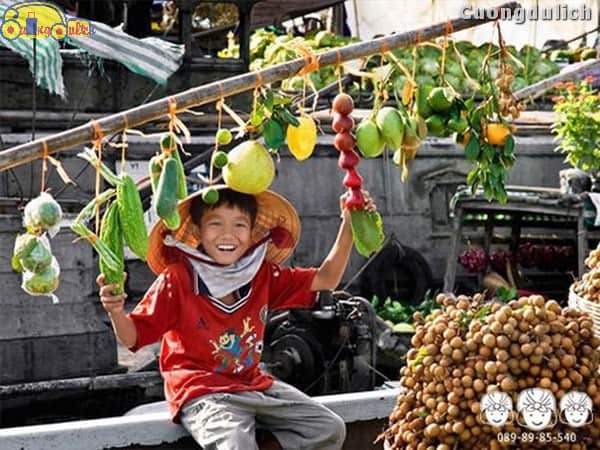
After tasting a variety of dishes to “rate” and asking for advice from many vendors and customers, Cuong concluded that when it comes to Cai Rang floating market, you cannot miss the most special dishes like noodles and rice noodles. Even on the boat, the pot of broth is always kept hot, which is why tourists choose to enjoy noodles, rice noodles, and sticky rice cakes, always emitting a thick smoke when coming to the market. Noodles, rice noodles, and sticky rice cakes on the boat are served with fresh vegetables, young jackfruit, thinly sliced meat, pig liver, and minced meat.
Sitting comfortably on the boat, savoring a hot bowl of noodles in the cold morning air is an unforgettable experience for tourists. Each dish here ranges from 30,000 to 35,000 Vietnamese dong. Many people who have visited the market recommend not to miss the fragrant and rich bowl of offal porridge. On the boat, vendors have to skillfully and carefully do everything. They are like balancing artists, skillfully scooping porridge into a bowl, adding meat, blood, and sprinkling green onions on top before quickly passing it to the customer. Just call out to the boat with the dish you like, the vendor will row close to the customer’s boat, tie it to the side, and quickly present the dish.
While eating and chatting with the vendors, Cuong also learned a lot of interesting things about this unique floating market in the Mekong Delta. When Cuong asked the vendors at Cai Rang floating market why there are boats and bamboo poles hanging but not selling or hanging this but selling that, he received the answer: “On the river, boats are always swaying with the flow of the river. Therefore, items like pomelos, mangoes, rambutans, longans… are hung to sell. As for food and drinks like rice, rice noodles, noodles… they cannot be hung because they will spill. That’s why we say hang this but sell that. There are also things hung up that are not for sale, and those are clothes. This is easier to understand because clothes are hung up after washing, once they are sold, what will people wear?”
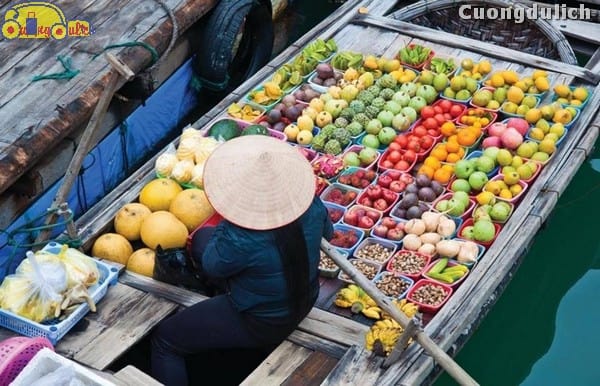
Cuong also discovered something very interesting that on many boats, canoes, and small boats, there are bamboo poles with coconut leaves hanging on them, can you guess what they are selling? Could it be coconut leaves? No, they are actually selling boats and canoes. You might wonder why hanging coconut leaves means selling boats and canoes. This is because, according to the traditional culture of the people in the Mekong Delta. Coconut leaves are a roofing material for houses, and a house is where people live. Therefore, when coconut leaves are hung on the bamboo poles, it means advertising the sale of their homes where they live.
While Cuong was enjoying a cup of coffee on a boat, he heard the nearby greeting of a local vendor. “Have a drink, my child. This is pure rice wine from the Mekong Delta, no alcohol. Drink it and I’ll find you a place to stay, it won’t cost you anything. I’ll take care of everything” – Mr. Chin – a man with a protruding belly and a friendly face, warmly invited Cuong.
According to Mr. Chin, currently, there are about 300-350 boats operating for trading at the Cai Rang floating market every day. Among them, about 200 boats move regularly, small boats come from fruit orchards to trade daily. The remaining over 100 large boats are anchored for a few days, sometimes even a month, and only move when they have sold all their goods to go and get more.
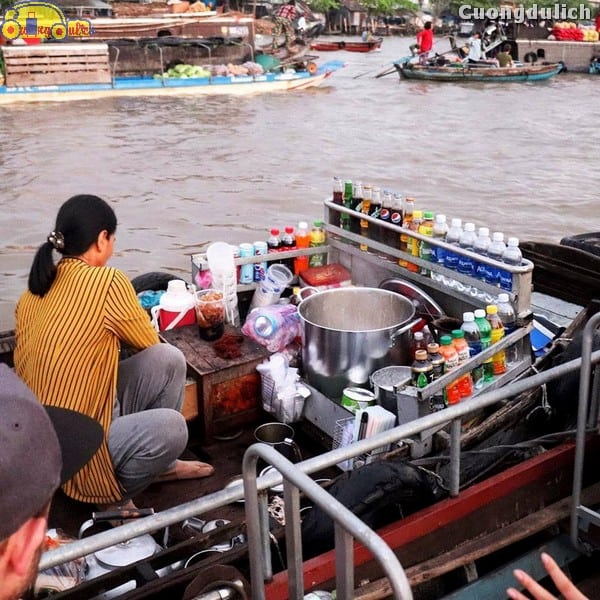
When Cuong had just finished eating a cheap bowl of noodles, another “mobile” eatery came by, with the cool voice of the owner saying, “Have some coffee, hot soy milk, my dear, made by me, only 10,000 VND per cup, my coffee is pure, you know,” and then she smiled cheerfully. The genuine and honest sales pitches of the people from the Mekong Delta, without any embellishments or exaggerated advertising, easily find their way into the hearts of tourists, making them remember the warm and hospitable people of the Mekong Delta.
Oh, almost forgot, a very special thing at the Cai Rang floating market is that everywhere you go, you can hear the folk songs of the women, mothers, and sisters, making Cuong feel like he’s returned to a simple countryside. “Oh, Can Tho, with white rice and clear water – Once you go there, you won’t want to leave,” eating a bowl of common noodles, listening to the rhythmic paddling of the boats, hearing the beloved homeland folk songs, the lively chatter of buyers and sellers, gazing into the distance at the hundreds of boats docking closely together, you will have unforgettable feelings about the life breath of the unique floating market of the Mekong Delta – Cai Rang market.
Did you know that the Cai Rang floating market is so famous that two Korean TV stations, KBS and EBS, have planned to choose the Cai Rang floating market to learn about the daily life, activities, and special dishes here. Surprisingly, the simple, rustic, and everyday scene of the Cai Rang floating market, when broadcasted, becomes artistic and beautiful like a vivid painting.
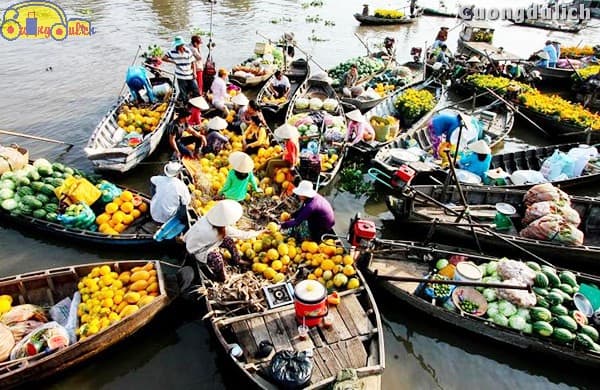
Especially, the locals here are extremely hospitable as they are willing to let visitors taste the specialty fruits grown in their own gardens. And the first experience of the Korean guy filming in that program was a piece of ripe golden mango, sweet and juicy, cut by the seller’s own hands.
Just by looking at the fresh yellow color of the mango flesh and the rough skin on the outside, food enthusiasts can tell that this is an extremely sweet mango. And not only mangoes, this guy also had the opportunity to enjoy a pineapple right on the boat after it was peeled by the seller. And the process of making coffee is just as delicious as in professional drip coffee shops. Although Vietnamese coffee is much stronger in flavor compared to Korean coffee, it is still recognized as very delicious.
One interesting thing that Cuong found is that when eating at Cai Rang floating market, you don’t have chairs or tables, sometimes just a long wooden stick placed across two boat edges, and there you have an ideal table to enjoy the food. Of course, the feeling of enjoying food right on the boat swaying on the water like this will definitely be different from sitting comfortably on the shore. Clearly, this is a very interesting activity that anyone visiting Cai Rang floating market in particular, or other floating markets in general, would want to participate in.
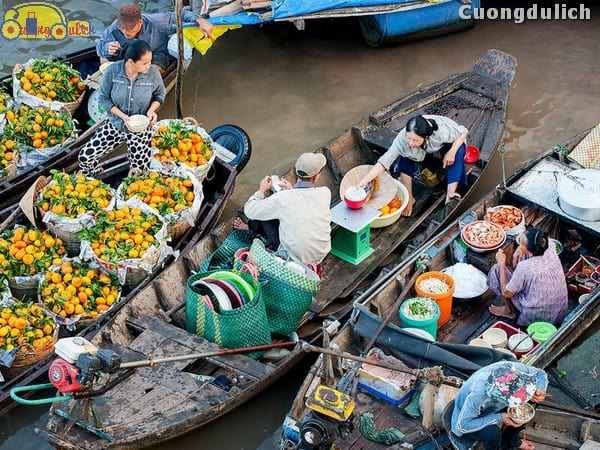
In general, Cuong is a land duck, unable to swim, so sitting on a boat when the waves hit, sometimes feels a bit scared, just afraid that the bowl of noodles might spill and lose the meal, but in general, the feeling of hot noodles, steaming and sitting in the middle of the swaying river, with the wind blowing gently, has its own charm.
Eating on the boat makes Cuong remember eating at small eateries in the alleys and corners of Hanoi. Many small eateries don’t even have tables and chairs for customers, just a plastic stool for customers to carry their bowl of noodles or hot pho, blowing and eating at the same time. Eating on the streets of Vietnam has its own simple joy, no need for fancy restaurants, fancy tables and chairs, just a small corner where the vendor can set up their goods, and customers sit around and enjoy. Sometimes Cuong finds it more endearing and approachable than dining in restaurants or hotels.
Another thing that Cuong will always remember about Cai Rang floating market is that you can also find many “mobile” coffee stalls serving a variety of menus from soy milk, black coffee, milk coffee, coconut water… If in Hanoi there’s lemon tea, sidewalk iced tea, and iced milk coffee at street stalls, coffee lovers can also find mobile coffee stalls at Cai Rang floating market with a menu that includes traditional Vietnamese coffee, iced coffee, and milk coffee. The flavorful and rustic dishes preserved in the simple life of the people on the river always attract tourists.
6. Specialty products from Cai Rang floating market that can be bought as gifts
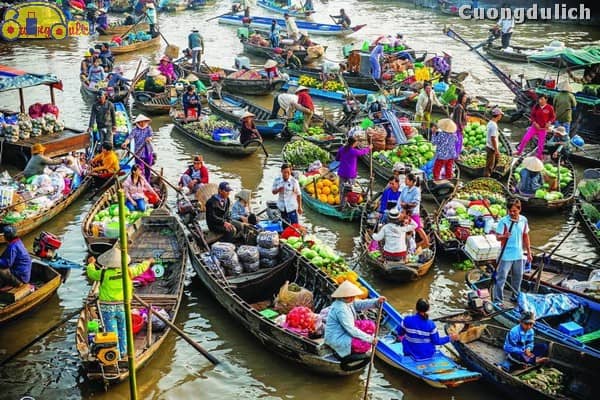
When visiting the floating market of Cai Rang, tourists will not only admire the magnificent natural scenery of the vast and rich river but also have the opportunity to purchase many attractive and fresh agricultural products.
Depending on the time of your trip, there will be corresponding fruits for you to freely choose and enjoy on the spot or buy as gifts for your loved ones at home.
You can buy rambutans, mangosteens, oranges, durians, Phong Dien strawberries… delicious at a “super cheap” price if you know how to bargain. Additionally, do not miss the chance to purchase some specialties such as dried snakes, dried lizards, and banh tet la cam – famous products of Can Tho.
7. Tips for visiting Cai Rang floating market without being ripped off
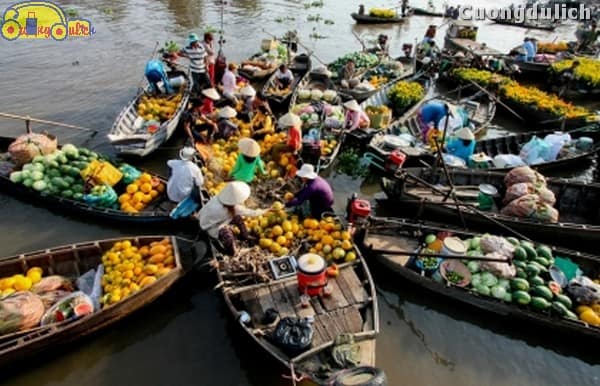
Cuong’s advice is to never buy fruits from the boats running around or those that call out to you from passing boats, as the prices are high and the quality is not guaranteed.
The boats at the end of the market usually have arrangements with the boat drivers to collect money from tourists. A bowl of noodles that costs between 20,000-25,000 VND is sold for 40,000 VND/bowl. You should ask for the price and negotiate before eating.
Usually, when you arrive at a shopping spot, the boat driver will receive a small tip. The more you buy, the more the boat driver earns. You should be upfront with the boat driver that you will not visit shopping spots. These spots usually sell dried goods, cakes, and are quite expensive.
Some boat drivers with questionable integrity may just take you around in circles or take you to shopping spots and claim they are out of time. You should hire boats from reputable tourist spots, not negotiate with locals at Ninh Kieu wharf.
When traveling with a boat driver, you should agree on terms beforehand and understand your rights. In 2, 3, 4 hours of boat rental, you have the right to ask the driver to take you around Cai Rang floating market for photo opportunities. You also have the right to change the itinerary. Remember to tip the boat driver if they provide good service!
Cai Rang floating market video
Hopefully, through Cuong’s detailed review, you have gained valuable experience for visiting Cai Rang floating market to discover delicious local foods and buy fruits as gifts without being ripped off. Additionally, you can book a comprehensive tour of the Mekong Delta with travel companies for convenient and cost-effective visits to Cai Rang floating market, without worrying about being scammed, and explore other famous tourist spots in Can Tho as well!
